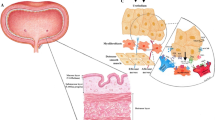Summary
The bladder is a dynamic organ that responds to the stress of outlet obstruction by rapidly increasing in mass and cellular content to compensate for increased urethral resistance. If the outlet obstruction is released prior to decompensation, the hypertrophied bladder will shrink, returning to normal size and cellularity. However, with chronic obstruction the bladder will continue to increase in mass, developing drastic alterations in the amount and composition of the extracellular matrix and, ultimately, losing the ability to function. The extensive tissue remodeling associated with each of these changes requires different bladder components to undergo cellular proliferation, cellular hypertrophy, and even programmed cell death (apoptosis). Each of these cellular processes is known to be regulated by various peptides that are referred to as growth factors. Herein we provide an overview of the growth factors that are known to influence the bladder in addition to a variety of experimental animal studies that putatively identify a role of four particular growth factors [basic fibroblast growth factor (bFGF), transforming growth factor-β (TGF-β), nerve growth factor (NGF), and epidermal growth factor (EGF)] in the obstructive bladder response.
Similar content being viewed by others
References
Barritault D, Groux-Muscatelli B, Caruelle D, Voisin MC, Chopin D, Palcy S, Caruelle JP (1991) aFGF content increases with malignancy in human chondrosarcoma and bladder cancer. Ann NY Acad Sci 638:387–393
Buttyan R, Jacobs BZ, Blaivas JH, Levin RM (1992) Early molecular response to rabbit bladder outlet obstruction. Neurourol Urodyn 11:225–238
Chen M-W, Kransnapolsky L, Levin RM, Buttyan R (1994) An early molecular response induced by acute overdistension of the rabbit urinary bladder. Mol Cell Biochem 132:39–44
Chen M-W, Wein AJ, Levin RM, Buttyan R (1995) A genetic and cellular response to unilateral ischemia of the rabbit urinary bladder. Mol Cell Biochem (submitted)
Elbadawi A, Meyer S, Malkowwicz SB (1989) Effects of short-term partial bladder outlet obstruction on the rabbit detrusor: an ultrastructural study. Neurourol Urodyn 8:89–116
Karim OM, Seki N, Mostwin JL (1992) Detrusor hyperplasia and expression of “immediate early” genes with onset of abnormal urodynamic parameters. Am J Physiol 263:R1284-R1290
Kato K, Wein AJ, Kitada S, Haugaard N, Levin RM (1988) The functional effect of mild outlet obstruction on the rabbit urinary bladder. J Urol 140:880–884
Koch C, Anderson D, Moran MF, Ellis C, Pawson T (1991) SH2 and SH3 domains: elements that control interactions of cytoplasmic signaling proteins. Science 252:668–674
Koo HP, Santarosa RP, Buttyan R, Shabsigh R, Olsson CA, Kaplan SA (1993) Early molecular changes associated with streptozotocin-induced diabetic bladder hypertrophy in the rat. Urol Res 21:375–381
Lee PL, Johnson DE, Cousens LS, Fried VA, Williams R (1989) Purification and complementary DNA cloning of a receptor for basic fibroblast growth factor. Science 245:57–60
Levin RM, Longhurst PA, Munson RC, Kato K, Wein AJ (1990) Effect of bladder outlet obstruction on the morphology, physiology and pharmacology of the bladder. Prostate 3[Suppl]:9–26
Levin RM, Wein AJ, Whitmore K, Monson FC, McKenna BAW, Ruggieri R (1990) Trypan blue as an indicator of urothelial integrity. Neurourol Urodyn 9:269–279
Levin RM, Longhurst PA, Monson FC, Haugaard N, Wein AJ (1993) Experimental studies on bladder outlet obstruction. In: Lepor H, Lawson RK (eds) Prostate diseases. W.B. Saunders, Philadelphia, pp 119–130
Lin HY, Wang X-F, Ng-Eaton E, Weinberg RA, Lodish HF (1992) Expression cloning of the TGF-β type II receptor, a transmembrane serine/threonine kinase. Cell 68:775–785
Lowenstein EJ, Daly RJ, Batzer AG, Li W, Margolis B, Lammers R, Ullrich A, Skolnik EY, Bar-Sagi D, Schlessinger J (1992) The SH2 and SH3 domain-containing protein GRB2 links receptor tyrosine kinase to ras signaling. Cell 70:431–442
Malkowicz SB, Wein AJ, Elbadawi A, Van Arsdalen K, Ruggieri MR, Levin RM (1986) Acute biochemical and functional alterations in the partially obstructed rabbit urinary bladder. J Urol 136:1324–1329
Mattiasson A, Uvelius B (1982) Changes in contractile properties in hypertrophic rat urinary bladder. J Urol 128:1340–1342
Messing EM (1990) Clinical implications of the expression of epidermal growth factor receptors in human transitional-cell carcinoma. Cancer Res 50:2530–2537
Monson RC, Wein AJ, Murphy EM, Levin RM (1994) Stimulation of DNA synthesis in rabbit bladder wall after partial outlet obstruction and acute overdistension. Neurourol Urodyn 13:51–62
Mostwin JL, Karim OM, Van Koeveringe G, Seki N (1994) Guinea pig as an animal model for the study of urinary bladder function in the normal and obstructed state. Neurouro Urodyn 13:137–145
Nexo E, Jorgensen PE; Hansen MR (1992) Human epidermal growth factor — on molecular forms present in urine and blood. Regul Peptide 42:75–84
O'Grady P, Lin Q, Huang SS, Huang JS (1992) Transforming growth factor-β type V receptor has a TGF-β stimulated serine/threonine specific autophosphorylation activity. J Biol Chem 267:21033–21037
Ravery V, Jouanneau J, Gil Diez S, Abbou CC, Caruelle JP, Barritault D, Chopin DK (1992) Immunohistochemical detection of acidic fibroblast growth factor in bladder transitional-cell carcinoma. Urol Res 20:211–214
Saito M, Longhurst PA, Tammela TLJ, Wein AJ, Levin RM (1993) Effects of partial outlet obstruction in the rat urinary bladder on micturition, characteristics, DNA synthesis and the contractile response to field stimulation and pharmacological agents. J Urol 150:1045–1051
Salido EC, Lakshmanan J, Fisher DA, Shapiro LJ, Barajas L (1991) Expression of epidermal growth factor in the rat kidney. An immunohistochemical and in situ hybridization study. Histochemistry 96:65
Santarosa R, Colombell M, Kaplan S, Monson F, Levin R, Buttyan R (1994) Hyperplasia and apoptosis: opposing cellular processes that regulate the response of the rabbit bladder to transient outlet obstruction. Lab Invest 70:503–510
Shoyab M, Plowman G, McDonald V, Garrett Bradley J, Todaro G (1989) Structure and function of human amphiregulin: a member of the epidermal growth factor family. Science 243:1074–1076
Steers WD, Kolbeck S, Creedon D, Tuttle JB (1991) Nerve growth factor in the urinary bladder of the adult regulates neuronal form and function. J Clin Invest 88:1709–1715
Author information
Authors and Affiliations
Rights and permissions
About this article
Cite this article
Chen, MW., Levin, R.M. & Buttyan, R. Peptide growth factors in normal and hypertrophied bladder. World J Urol 13, 344–348 (1995). https://doi.org/10.1007/BF00191215
Issue Date:
DOI: https://doi.org/10.1007/BF00191215




